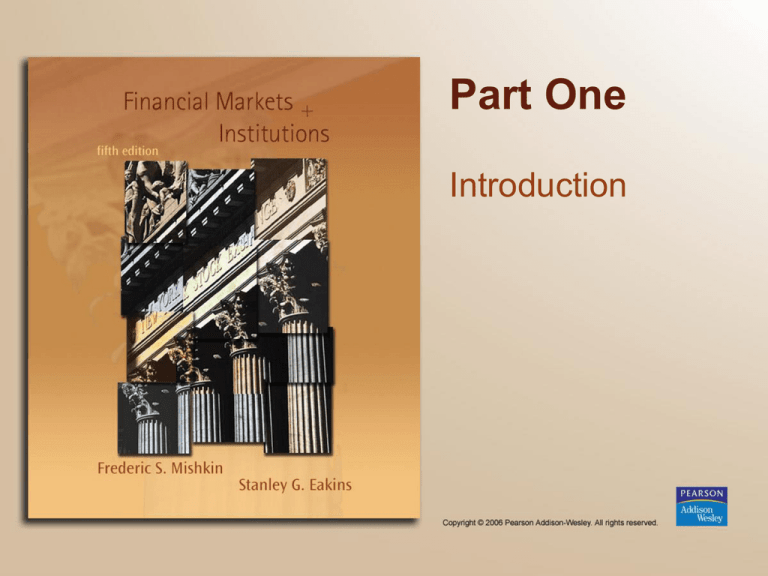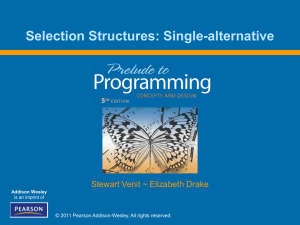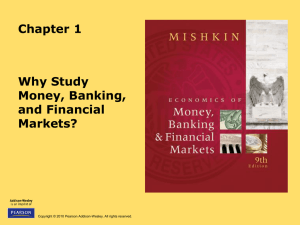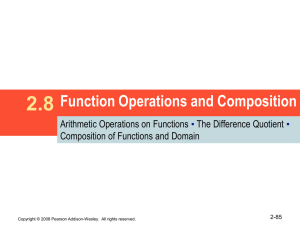
Part One
Introduction
Chapter 1
Why Study
Financial Markets
and Institutions?
Chapter Preview
• We preview subjects of interest to anyone who is
a part of a productive society. We motivate how
financial markets and institutions have significant
impact on important questions about our financial
well-being. Topics include:
– Why Study Financial Markets?
– Why Study Financial Institutions?
– Applied Managerial Perspective
– How Will We Study Financial Markets and Institutions
Copyright © 2006 Pearson Addison-Wesley. All rights reserved.
1-3
Why Study Financial Markets?
1. Channels funds from savers to
investors, thereby promoting
economic efficiency.
2. Affects personal wealth and behavior
of business firms.
Copyright © 2006 Pearson Addison-Wesley. All rights reserved.
1-4
Why Study Financial Markets?
• Well functioning financial markets, such as
the bond market, stock market, and foreign
exchange market, are key factors in
producing high economic growth.
• We will briefly examine each of these
markets, key statistics, and how we will
examine them throughout this course.
Copyright © 2006 Pearson Addison-Wesley. All rights reserved.
1-5
Why Study Financial Markets?
Debt Markets & Interest Rates
• Debt markets, or bond markets, allow
governments, corporations, and individuals
to borrow to finance activities.
• The relationship between these markets
and interest rates will be established in
several chapters throughout this book.
Copyright © 2006 Pearson Addison-Wesley. All rights reserved.
1-6
Why Study Financial Markets?
Debt Markets & Interest Rates
• The next slide shows historical interest
rates in various sectors of the bond market:
Long-Term U.S. Government rates, ShortTerm U.S. Government rates, and
corporate rates.
• We will study these further in several
chapters, examining the types and
characteristics of bonds, as well as theories
on how rates are determined.
Copyright © 2006 Pearson Addison-Wesley. All rights reserved.
1-7
Bond Market and Interest Rates
Figure 1.1 Interest Rates on Selected Bonds, 1950–2001
Copyright © 2006 Pearson Addison-Wesley. All rights reserved.
Complete list of interest rates
http://www.federalreserve.gov/releases
1-8
Why Study Financial Markets?
The Stock Market
• The stock market is the market where
stocks, representing ownership in a
company, are traded.
• Of all the active markets, it receives the
most attention, probably because it is
the place where people get rich (and
poor) quickly.
Copyright © 2006 Pearson Addison-Wesley. All rights reserved.
1-9
Why Study Financial Markets?
The Stock Market
• The next slide shows the level of the Dow
Jones Industrial Average over the last 55
years. Note how volatile stock prices have
been, especially over the last five years.
• In future chapters, we will examine the role
of the stock market, as well as how prices
react to information in the marketplace.
Copyright © 2006 Pearson Addison-Wesley. All rights reserved.
1-10
Stock Market
Figure 1.2 Stock Prices as Measured
by the Dow Jones Industrial Average, 1950–2005
Copyright © 2006 Pearson Addison-Wesley. All rights reserved.
1-11
Why Study Financial Markets?
The Foreign Exchange Market
• The foreign exchange market is where
international currencies trade and
exchange rates are set.
• Although most people know little about this
market, it has a daily volume around
$1 trillion!
Copyright © 2006 Pearson Addison-Wesley. All rights reserved.
View historical financial data and forecasts at
http://www.forecasts.org/data/index.htm
1-12
Why Study Financial Markets?
The Stock Market
• The next slide shows how the U.S. dollar
has fluctuated in price against a basket of
foreign currencies.
• In future chapters, we will examine how
exchange rates are determined in both the
short- and long-run.
Copyright © 2006 Pearson Addison-Wesley. All rights reserved.
1-13
Foreign Exchange Market
Figure 1.3 Exchange Rate of the U.S. Dollar
for a Basket of Foreign Currencies, 1970–2004
Copyright © 2006 Pearson Addison-Wesley. All rights reserved.
1-14
Why Study Financial Institutions?
We will also spend considerable time discussing
financial institutions—the corporations,
organizations, and networks that operate the socalled “marketplaces.” We will look at:
1. Central Banks and the Conduct of
Monetary Policy
– The role of the Fed and foreign counterparts
2. Structure of the Financial System
– Helps get funds from savers to investors
Copyright © 2006 Pearson Addison-Wesley. All rights reserved.
1-15
Why Study Financial Institutions?
3. Banks and Other Financial Institutions
– Includes the role of insurance companies, mutual
funds, pension funds, etc.
4. Financial Innovation
– Focusing on the improvements in technology and its
impact on how financial products are delivered
5. Managing Risk in Financial Institutions
– Focusing on risk management in the
financial institution.
Copyright © 2006 Pearson Addison-Wesley. All rights reserved.
1-16
Applied Managerial Perspective
• Financial institutions are among the largest
employers in the U.S. and often pay
high salaries.
• Knowing how financial institutions are
managed may help you better deal
with them.
Copyright © 2006 Pearson Addison-Wesley. All rights reserved.
1-17
How We Study Financial Markets
and Institutions
• Basic Analytic Framework
1. Simplified approach to the demand for assets
2. Concept of equilibrium
3. Basic supply and demand approach to
understand behavior in financial markets
4. Search for profits
5. Transactions cost and asymmetric
information approach to financial structure
6. Aggregate supply and demand analysis
Copyright © 2006 Pearson Addison-Wesley. All rights reserved.
1-18
How We Study Financial Markets
and Institutions
• Features
1. Case studies
2. Applications and Numerical Examples
3. Special Interest Boxes
4. Following the Financial News boxes
5. Reading the Wall Street Journal
6. Practicing Financial Institution
Manager applications
Copyright © 2006 Pearson Addison-Wesley. All rights reserved.
1-19
Exploring the Web
• Web Exercise
The World Wide Web is an enormous resource
for present and historical information. We will
periodically present web exercises to
introduce some of the important locations for
information, and how to use it.
Copyright © 2006 Pearson Addison-Wesley. All rights reserved.
1-20
Exploring the Web
• Web Exercise
The next three slides (starting on page 11 in
the text) show you how to (1) find historical
interest rates from the Fed and save the
information, (2) how to import the data into
Excel, and (3) how to examine the information.
Copyright © 2006 Pearson Addison-Wesley. All rights reserved.
1-21
Exploring the Web
Exploring the Web
Exploring the Web
Chapter Summary
• Why Study Financial Markets?: the three
primary markets (bond, stock, and foreign
exchange) were briefly introduced.
• Why Study Financial Institutions?: the
market, institutions, and key changes
affecting these were outlined.
Copyright © 2006 Pearson Addison-Wesley. All rights reserved.
1-25
Chapter Summary (cont.)
• Applied Managerial Perspective: the book
will often present material to better
understand how actual managers use the
information in daily operations.
• How We Will Study Financial Markets and
Institutions: we outlines the three key
components: analytical framework,
features, and web exercises.
Copyright © 2006 Pearson Addison-Wesley. All rights reserved.
1-26







